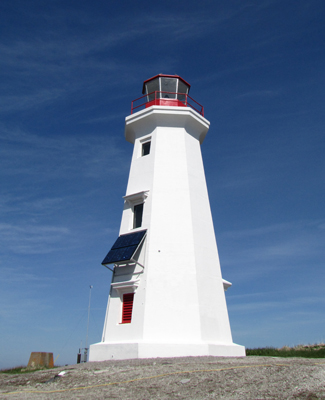Île aux Perroquets Lighthouse
Heritage Lighthouse
Longue-Pointe-de-Mingan, Quebec

Corner view
© Parks Canada | Parcs Canada
Address :
Île aux Perroquets, Longue-Pointe-de-Mingan, Quebec
Recognition Statute:
Heritage Lighthouse Protection Act (S.C. 2008, c 16)
Designation Date:
2014-02-07
Dates:
-
1951 to 1951
(Construction)
-
1888 to 1888
(Established)
Other Name(s):
-
Île aux Perroquets Lighthouse
(Designation Name)
Description of Historic Place
The Île aux Perroquets heritage lighthouse is located on Île aux Perroquets, at the western extremity of the Mingan Islands in Quebec and is located within the Mingan Archipelago National Park Reserve of Canada. The lighthouse is a three-storey white tapered octagonal reinforced concrete tower capped by an octagonal red fibreglass lantern and topped with a decorative roof cover. The tower is typical of replacement towers built by the Government of Canada in a modernization program of Canada’s lightstations in the years following the Second World War. Fully automated in 1981, it is nevertheless operational.
There are seven related buildings on the site that contribute to the heritage character of the lighthouse: (1) the 1951 senior keeper’s (warden) dwelling; (2) the 1951 assistant keeper’s (warden) dwelling; (3) the c. 1950s fog alarm building; (4) the 1952 forge building; (5) the 1954 storage shed; (6) the 1952 chicken coop; and, (7) the 1908-1915 boathouse (stage).
Heritage Value
The Île aux Perroquets Lighthouse is a heritage lighthouse because of its historical, architectural, and community values.
Historical values
The Île aux Perroquets heritage lighthouse is associated with the improvement of lightstation infrastructure in the 1950s, and more particularly in the Gulf of St. Lawrence. It is a very good example of the modernization and changes taking place in lighthouse technology during that time.
The Île aux Perroquets lightstation has always played an important role in the life of mariners on the river. The present lighthouse was constructed in 1951 to replace the wooden lighthouse established in 1888, and allowed safer navigation for fishing boats and ships delivering mail and supplies to the area. It brought major benefits to the local fishing industry, an economic base for the region. The current lighthouse also illustrates the need for a modern lighthouse to better serve trans-Atlantic shipping as well as the increase in marine traffic toward the middle of the 20th century associated with mineral development in the Lac Allard and Lac Tio regions north of Havre-Saint-Pierre.
Architectural values
The Île aux Perroquets heritage lighthouse is a very good example of a neo-classical-style reinforced concrete lighthouse that reflects the formal three-part classical definitions of base, shaft and capital. It has a restrained aesthetic design that nevertheless includes simple details that add to the visual appeal of its functional structure, such as: a flared cornice, a door surmounted by a pediment and windows surmounted by poured-concrete flat hoods, as well as the traditional red and white exterior colour scheme.
The lighthouse was built using common, durable materials according to a standard plan that was prepared by the Department of Transport. It illustrates the popularity and versatility of the octagonal reinforced-concrete tower model in Canada.
Community values
The Île aux Perroquets heritage lighthouse establishes the site’s current character, since the island is exclusively associated with the function of the lightstation. The relationship between the lighthouse and its setting within an evolved historic lightstation has been well preserved.
The lighthouse is a familiar landmark in the Jacques Cartier Strait. The lightstation has provided a marine aid to navigation for over a century, and its presence, together with other lightstations established in the Mingan Archipelago region, especially those on Anticosti Island, helped reduce the area’s isolation. Written works left by two of the lighthouse’s keepers and the wife of a third lightkeeper have raised regional awareness of the importance of the lighthouse for their community. The lighthouse and its related buildings are symbolic of the region’s maritime heritage.
Related buildings
Seven related buildings, as listed above, contribute to the heritage character of the lighthouse.
Character-Defining Elements
The following character-defining elements of the Île aux Perroquets Lighthouse should be respected:
— its intact, as-built structural form, height, profile and proportions;
— its tapered octagonal reinforced three-storey concrete tower;
— its red octagonal fibreglass lantern topped with a decorative vent cover;
— its cornice with a railed gallery platform covered with welded metal plates;
— its triangular pediment over of the main door;
— its poured-in place concrete flat hoods over the windows;
— its traditional red and white exterior colour scheme; and,
— its visual prominence in relation to the water and landscape.
The following character-defining elements of the related buildings should be respected:
— their respective built forms, profiles and proportions;
— their traditional red and white exterior colour schemes;
— their contextual relationships to the lighthouse within an evolved historic lightstation setting.